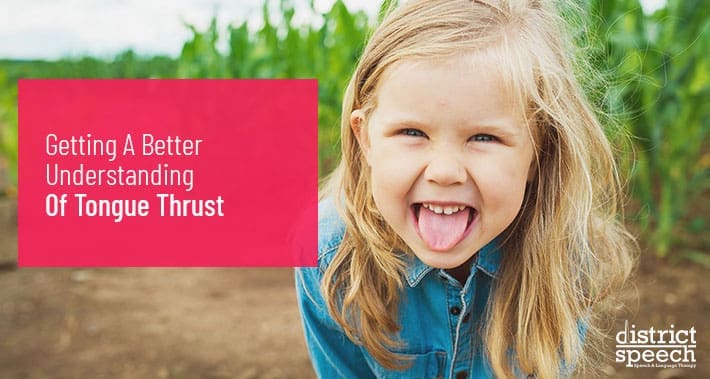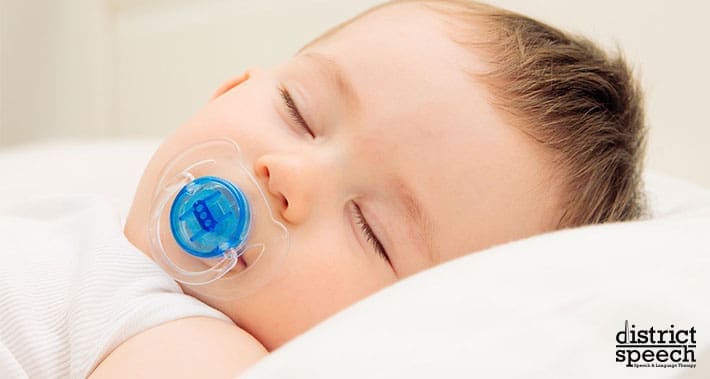
Your tongue is one of the most important parts of your mouth.
It’s a complex muscle that plays a role in eating, speech, and breathing.
Problems with your tongue, like tongue thrust, can affect all these aspects of your mouth.
If your child has tongue thrust, the most obvious sign from your perspective will be that they’re having a problem pronouncing S and Z sounds.
Sometimes a family doctor will refer a patient because they’ve noticed a child breathing primarily through their mouth.
The good news is that tongue thrust is a treatable condition.
Here at District Speech, we provide speech therapy treatments orofacial myofunctional disorders like tongue thrust.
If you’re concerned your child may have developed tongue thrust, have a read below for more information.
What Is Tongue Thrust?
Tongue thrust is a developmental issue, and is quite common in children.
In fact, according to research compiled by ASHA, tongue thrust may affect up to half of US children.
It occurs when the tongue presses further forward in the mouth than normal.
In orthodontics, they call this condition an “open bite”.
What causes it?
Well, it often originates in infancy.
When your child had no teeth, they needed to press their tongue against their lips so they could create enough of a seal to swallow.
Once teething begins, infants usually begin to grow out of it.
Most children are past this natural tongue thrust by the age of four.
Symptoms Of Tongue Thrust
A surprising sign common in children is being a messy eater, because of how tongue thrust can affect your child’s teeth.
Alternately, eating particularly fast or slow are other signs of difficulty eating, due to tongue thrust.
When tongue thrust and poor tongue posture makes it difficult for kids to breathe through their nose, there is a new tell tale sign: a child who breathes through their mouth.
This, in turn, causes abnormalities in the growth of the jaw.
This can lead to structural issues, such as a child not being able to close their lips properly.
It may cause them to have a bite that doesn’t close fully – meaning their upper and lower teeth don’t meet.
It also may cause excessive drooling in your child, since they can’t fully close their mouths or use their tongue to control their saliva.
Children with tongue thrust often sleep with their mouths open, because they are so accustomed to it being open all day.
You can also sometimes see their tongue visible between their teeth.
Then, of course, there are sometimes speech issues.
It’s common for children with tongue thrust to have difficulty pronouncing Z and S sounds.
This is partially due to how important your teeth and tongue are for speech.
RELATED: Top Signs Your Toddler May Have A Speech Disorder

In Babies
As we mentioned above, very young infants need to use tongue thrust in order to swallow at all, including during feeding.
As the child gets older, their muscles develop, and as they move to more solid food, they tend to engage in tongue thrusting less and less until it disappears completely.
The problem may lie in the use of pacifiers, or the nipples on bottles.
Some argue that prolonged use of either can result in lingering issues.
Thumb sucking is another potential culprit, because it also requires the same sucking motion.
Tongue tie, which sounds like a fictional condition, is actually the name for when the band of tissue beneath the tongue is abnormally taut.
This can also cause tongue thrust, because it affects the placement of the tongue by forcing it farther back in the mouth instead of being able to move freely.
Sometimes allergies can cause adenoids or chronically swollen tonsils, which can in turn lead to tongue thrust.
RELATED: Spotting The Early Signs Of Speech And Language Disorders
In Adults
Adults who suffer from tongue thrust have usually brought it with them from childhood and it has remained untreated.
Sometimes, though, adults can develop tongue thrust in adulthood.
Similar to kids, this is usually due to allergies or swelling in their adenoids or tonsils.
However, in adults, we have to also consider lifestyle and stress levels.
These can be a factor in the development or maintenance of tongue thrust and its symptoms.
The symptoms are similar in adults as in children, though they may not be as apparent.
A noticeable feature in adults that have carried tongue thrust from childhood is an elongated facial structure.
This is the result of a lifetime of being unable to properly close your mouth properly.
You may also have an abnormally large tongue, and may even drool more often.
Often in adults, because your front teeth don’t match up properly, biting into certain foods may be painful.
You may also notice you can’t even bite certain foods properly at all.
Complications From Tongue Thrust
Although tongue thrust might sound harmless, it actually can result in some significant complications.
Basically, chronic tongue thrust can alter the form and mechanics of your jaw.
This can cause difficulty and pain with eating and difficulty speaking.
It can also cause malformed teeth, due to the pressure of your tongue on the back of your teeth.
There is also the complication of speech development.
Tongue thrust can cause a lisp on certain sounds or other issues with your speech.
Finally, you may notice your tongue sticks out between your teeth.
How Do We Diagnose Tongue Thrust?
Many healthcare professionals have the ability to diagnose tongue thrust, including your family doctor or pediatrician, dentists, orthodontists, and – of course – speech language pathologists such as ourselves.
We generally will start by observing the way your child speaks and swallows, while checking in on some of the symptoms you’ve noticed.
We also check on their allergies, whether or not they may have tongue-tie, and whether your child might ‘reverse swallow’.
Reverse swallowing occurs when your child swallows with their mouth open and tongue between their teeth.
They may use the movement of their head to force food into the back of the throat, and swallow with movement of their jaw instead of just their tongue, like they should.
On occasion, we have to engage other professionals in the diagnosis, including a gastroenterologist or ENT specialist, depending on the symptoms we’re seeing.
How Does A Speech Therapist Treat Tongue Thrust?
Speech therapists will often use a treatment called orofacial myology.
This involves exercises to improve and correct the movement of facial and jaw muscles.
This is an ongoing treatment that helps correct the placement of your child’s tongue, lips, and jaw.
Orofacial myology can also address abnormal swallowing habits your child might have.
Next, we would likely address any speech impediments that may have developed.
Orofacial myology will help with addressing speech impediments by correcting the musculature of your face and jaw.
Your speech therapist may also use more typical speech therapy exercises like the kind used to treat lisps.
We’ll also work to address any underlying speech disorders.
Book An Appointment With District Speech
If you or your child has tongue thrust, we can help.
As experts in this condition, we will make sure your child has the right treatment plan and team around them.
Call now to book your appointment with District Speech, and we’ll put you on the path right away.
1300 I St NW, Suite 400 E,
Washington, DC 20005
- https://g.page/districtspeech
District Speech and Language Therapy specializes in speech therapy, physical therapy, and occupational therapy solutions, for both children and adults, in the Washington D.C and the Arlington Virginia areas.